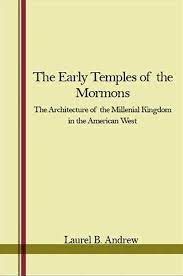Articles/Essays – Volume 12, No. 2
Sacred Architecture | Laurel B. Andrew, The Early Temples of the Mormons: The Architecture of the Millennial Kingdom in the American West
Most writing about the Church’s sacred architecture of the nineteenth century (mainly theses and dissertations) has been restricted to the study of a single temple and tends to be historical rather than critical. Laurel Andrew’s work, which grew from her PhD dissertation at the University of Michigan, attempts to integrate an architectural analysis of all the temples with the whole social and cultural history of the Mormons. Although noted architectural historians have always included Mormon temples in their studies, they have usually left important questions unanswered. What is the meaning of the temple in Mormon life? What is its relationship to Mormon theology? Ms. Andrew, in attempting to answer these questions, concludes that the last century actually produced an identifiable Mormon style in monumental architecture. This book makes a real contribution to the recent surge of interest in nineteenth century American buildings.
The first three chapters concern Mormonism, the role of the temple in Mormon theology, and the origins of the temples at Kirtland and Independence. The rest of the text covers the designs and historical backgrounds of the Nauvoo temple through the temple at Manti, including development of a Mormon architectural symbolism, the influence of Masonry, the changing ritual within the Church and the role of Brigham Young as designer. It ends with an architectural analysis of the various temples.
Ms. Andrew describes the origins of temple architecture despite the paucity of primary sources. Determining the actual roles of such “architects” as William Weeks, Truman Angell, Senior and Junior and William Folsom was difficult, but she has admirably unraveled their relationships to the various temples and church leaders. Even though most of the Utah temples have undergone substantial interior renovation since the last century, she has managed to reconstruct and analyze a great many facts about the exteriors and interiors of the temples. She displays her strong familiarity with American architecture and its antecedents in her discussions of the Kirtland and Independence temples. She sustains this in discussing the Salt Lake City temple with its Masonic imagery and its fortress-like castellated style of the early gothic revival. She makes a strong argument that this style, occasionally found in the secular architecture of America, is derived from Masonic temples of the eastern United States. Its appearance in the Salt Lake City temple established the basis for further adaptation in the other Utah temples. She believes that what has occurred in these four temples is the emergence of a Mormon style, but whether or not four closely related temples can constitute an architectural style is open to debate.
In her architectural analysis, however, she could have used more of the extant plans and drawings to visually reinforce her statements so that the reader can judge certain points. In her discussion of the Independence temple, she provides only the facade design without additional plans and elevations. She should have provided these if they are not available from another printed source.
The author also omitted recently published works relevant to her study. Since 1973, when she completed her dissertation, a number of articles and some theses have dealt with Mormon and Utah architecture. These include articles in Dialogue, Sunstone and particularly in the Utah Historical Quarterly issue “Towards an Architectural Tradition” (43:3 Summer 1975). The latter publication would have been helpful in the author’s comments on William Folsom’s designs for the Manti temple which have recently been examined by Paul Anderson.
Ms. Andrew’s writing style vacillates between an academic and a popular approach. In some cases arguments are well documented while others are too abbreviated. Her bibliography is helpful, but the lack of an introduction and an index is unfortunate. Photographs and drawings are not properly scaled to the book’s format, and some are of poor quality.
Despite this, Ms. Andrew’s study is a much needed interpretation of sacred buildings, a basis for further critical studies on the Church and its architecture and a welcome addition to the growing research on Mormon and Utah architectural history.
The Early Temples of the Mormons: The Architecture of the Millennial Kingdom in the American West. By Laurel B. Andrew. Albany: State University of New York, 1978, 218 pp. $15.00.


 Back to full Issue
Back to full Issue

